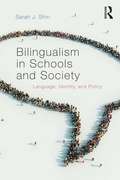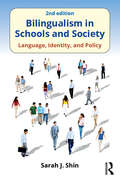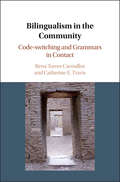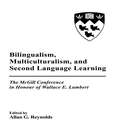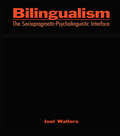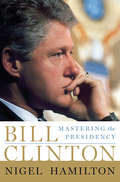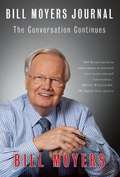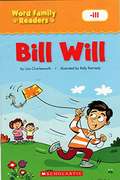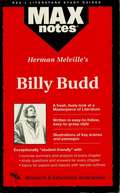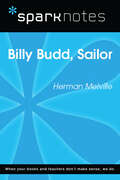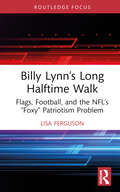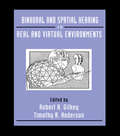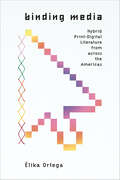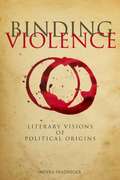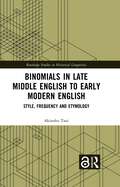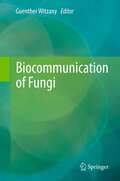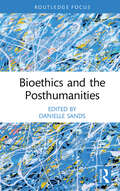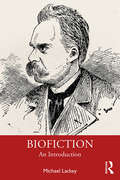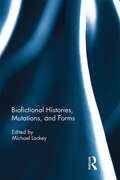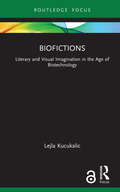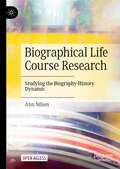- Table View
- List View
Bilingualism in Schools and Society: Language, Identity, and Policy
by Sarah J. ShinThis book is an introduction to the social and educational aspects of bilingualism. It presents an overview of a broad range of sociolinguistic and political issues surrounding the use of two languages, including code-switching in popular music, advertising, and online social spaces. It offers a well-informed discussion of what it means to study and live with multiple languages in a globalized world and practical advice on raising bilingual children.
Bilingualism in Schools and Society: Language, Identity, and Policy, Second Edition
by Sarah J. ShinThis revised edition of Bilingualism in Schools and Society is an accessible introduction to the sociolinguistic and educational aspects of and the political issues surrounding bilingualism, including code-switching in popular music, advertising, and online social spaces. It also addresses the personal aspect of the topic in a well-informed discussion of what it means to study and live with multiple languages in a globalized world and practical advice on raising bilingual children. Extensive new material has been added that deals with more holistic understandings of bilingual performance, including translanguaging, flexible bilingualism, and code-meshing; blending standard and vernacular languages/dialects in hybrid texts; and recent developments in policies surrounding the education of English Learners and EL assessment, including Common Core State Standards (CCSS), PARCC and SBAC testing, WIDA and ELPA21 language assessments, and Every Student Succeeds Act (ESSA). Updated and new discussions on community-based heritage language programs and 'super-diversity' further enhance this new edition, along with updated statistics on bilingual populations and the world's top languages. Each chapter includes lists of further readings, helpful digital resources and study questions, as well as student activities and boxed vignettes. Firmly grounded in the analysis of empirical work with bilingual children and adults in various multilingual settings throughout the world, Bilingualism in Schools and Society is the ideal text for courses on bilingualism in language education programs.
Bilingualism in the Community: Code-switching and Grammars in Contact
by Catherine E. Travis Rena Torres CacoullosDoes the use of two languages by bilinguals inevitably bring about grammatical change? Does switching between languages serve as a catalyst in such change? <P><P>It is widely held that linguistic code-switching inherently promotes grammatical convergence - languages becoming more similar to each other through contact; evidence for this, however, remains elusive. A model of how to study language contact scientifically, Bilingualism in the Community highlights variation patterns in speech, using a new bilingual corpus of English and Spanish spontaneously produced by the same speakers. Putting forward quantitative diagnostics of grammatical similarity, it shows how bilinguals' two languages differ from each other, aligning with their respective monolingual benchmarks. The authors argue that grammatical change through contact is far from a foregone conclusion in bilingual communities, where speakers are adept at keeping their languages together, yet separate. The book is compelling reading for anyone interested in bilingualism and its importance in society.
Bilingualism in the Spanish-Speaking World
by Austin, Jennifer and Blume, María and Sánchez, Liliana Jennifer Austin María Blume Liliana SánchezBilingualism has given rise to significant changes in Spanish-speaking countries. In the US, the increasing importance of Spanish has engendered an English-only movement; in Peru, contact between Spanish and Quechua has brought about language change; and in Iberia, speakers of Basque, Galician and Catalan have made their languages a compulsory part of school curricula and local government. This book provides an introduction to bilingualism in the Spanish-speaking world, looking at topics such as language contact, bilingual societies, bilingualism in schools, code-switching, language transfer, the emergence of new varieties of Spanish, and language choice - and how all of these phenomena affect the linguistic and cognitive development of the speaker. Using examples and case studies drawn primarily from Spanish/English bilinguals in the US, Spanish/Quechua bilinguals in Peru and Spanish/Basque bilinguals in Spain, it provides diverse perspectives on the experience of being bilingual in distinct cultural, political and socioeconomic contexts.
Bilingualism, Multiculturalism, and Second Language Learning: The Mcgill Conference in Honour of Wallace E. Lambert
by Allan G. ReynoldsThis collection pays tribute to Professor Wallace E. Lambert and his contributions to the fields of language and linguistics. Each chapter, written by an internationally renowned theorist or researcher, traces the currents of theory and research within the topic area to the present day, provides a state-of-the-art review of the topic, and offers an outline for future research directions. The book concludes with an overview from Professor Lambert that critically examines the impact of the ideas in each individual chapter. This volume is organized around the three areas where Professor Lambert's unique contributions are most substantial and most evident: bilingualism, multiculturalism, and second language learning. Specifically, the papers presented discuss the topics of social, psychological, cognitive, and neuropsychological aspects of bilingualism and second language learning, the psychology of inter-group relations and multiculturalism, bilingual/immersion education, and language planning. Note: Royalties earned from sales of this book will go to the Wallace E. Lambert Student Research Fund at McGill University for use by students interested in second language acquisition, bilingualism, and/or multiculturalism.
Bilingualism: The Sociopragmatic-Psycholinguistic Interface
by Joel WaltersIn the past 30 years, the study of bilingualism processing has been conducted independently by two fields, psycholinguistics and sociolinguistics. This volume merges these two fields, addressing one of the tough problems dividing researchers in bilingualism, conceptually as well as methodologically. Joel Walters proposes a new approach to bilingualism processing--the Sociopragmatic-Psycholinguistic (SPPL) Model--which presents language as a social phenomenon. The author accomplishes this by identifying and organizing evidence from a wide range of linguistic disciplines, merging sociopragmatics, discourse analysis, and ethnography with social cognition, psycholinguistics, and neuroscience. By extension, the author offers convincing explanations of how related fields can profit from a comprehensive bilingual processing model. As a result, Joel Walters delivers a well-organized, comprehensive model that is thought through at every level. This book appeals to graduate students, scholars in the fields of linguistics, bilingualism, second language acquisition, psycholinguistics, and sociolinguistics. It is useful to researchers for its comprehensiveness and methodological acumen and may be appropriate as a supplementary textbook for graduate-level courses in bilingualism or for seminars on similar topics.
Bill Clinton: Mastering the Presidency
by Nigel HamiltonFrom best-selling, award-winning biographer Nigel Hamilton, this is an insightful, prodigiously researched, and wonderfully readable account of Bill Clinton’s first term in office. It shows how a well-meaning but naïve new president failed to assert true leadership in his first two years, and then illustrates how, in an astonishing act of self-reinvention, the president turned defeat into victory. Bill Clinton: Mastering the Presidency is a gripping tale of hubris and redemption-and a chronicle of one of the most dramatic reversals of fortune in modern American politics.
Bill Moyers Journal: The Conversation Continues
by Bill MoyersOne of the most highly rated public affairs programmes on American television, Bill Moyers' Journal drew up to two million weekly viewers from 2007 to 2010. With incisive, morally engaging text, this stunning companion brings Moyers' groundbreaking work to the page. Featuring extensive new commentary from Bill Moyers, it is an unparalleled guide to the debates, the cultural currents and above all the fascinating people that have so powerfully shaped today's world.
Bill Will (Word Family Readers)
by Liza CharlesworthLet's Learn Readers boost key literacy skills through engaging, easy-to-read stories. Jump-start phonics learning with these super-fun books! For use with Grades K-2.
Billy Budd (MAXNotes Literature Guides)
by Miriam MinkowitzREA's MAXnotes for Herman Melville's Billy Budd MAXnotes offer a fresh look at masterpieces of literature, presented in a lively and interesting fashion. Written by literary experts who currently teach the subject, MAXnotes will enhance your understanding and enjoyment of the work. MAXnotes are designed to stimulate independent thought about the literary work by raising various issues and thought-provoking ideas and questions. MAXnotes cover the essentials of what one should know about each work, including an overall summary, character lists, an explanation and discussion of the plot, the work's historical context, illustrations to convey the mood of the work, and a biography of the author. Each chapter is individually summarized and analyzed, and has study questions and answers.
Billy Budd (SparkNotes Literature Guide Series)
by SparkNotesBilly Budd (SparkNotes Literature Guide) by Herman Melville Making the reading experience fun! Created by Harvard students for students everywhere, SparkNotes is a new breed of study guide: smarter, better, faster.Geared to what today's students need to know, SparkNotes provides:chapter-by-chapter analysis explanations of key themes, motifs, and symbols a review quiz and essay topics Lively and accessible, these guides are perfect for late-night studying and writing papers.
Billy Lynn’s Long Halftime Walk: Flags, Football, and the NFL’s “Foxy” Patriotism Problem (Routledge Focus on Literature)
by Lisa FergusonThis book examines how the game of football and militarism have historically overlapped due to their shared celebration of strength, might, and besting a clear and definitive foe. Nevertheless, since September 11, a variety of staged patriotic vignettes dominated most NFL broadcasts, giving the once easy and unforced union a stilted feel. That the War on Terror became a fixture of modern- day Super Bowls was easy to portend; what was more difficult to predict was the imprint it would leave on U.S. citizens and American politics. Ben Fountain’s award- winning novel, Billy Lynn’s Long Halftime Walk, reveals what passes for patriotism in a country that has reduced the sober and stark reality of combat to pageantry and production for the crowd back home, leaving our troops to unwittingly play the part of entertainers, destined to be sexualized just like the cheerleaders and dancers so frequently performing alongside them.
Billy Wants It All: Money (Billy Growing Up Ser. #7)
by James MinterFor 7 to 11 year old boys and girls. Children, usually driven by peer-pressure, want the latest toys, electronics and clothes, but have little understanding of the value of money or where it comes from. This is essential knowledge for later years. <P><P>Billy wants a new skateboard and games controller, but doesn’t understand why he can’t have them bought for him. He doesn’t pay anything towards other household costs, so why does he have to contribute to a toy? His mum and dad are presented with some large and unexpected household bills, but once Billy understands the challenges his parent’s face, it makes him respect them more, and understand how much they work to invest in their family. <P><P>Does Billy get a new skateboard? Who pays for it? Will the family afford to go on holiday this year? <P><P>Billy Wants It All is the seventh title in the Billy Books series. Each book addresses a unique topic—bullying, arrogant pride, jealousy, lying, stealing, lack of self-belief, understanding money, and secrets. Written to help parents, guardians and teachers deal with the issues that challenge pre-teen children; each topic is presented in a gentle way through storytelling. Setting the issues in a meaningful context helps children to understand the challenges, and to see things from a different perspective. The books act as icebreakers allowing for discussions of difficult subjects. Additionally, each title is supported by a free activity book to reinforce the learning, while having fun. <P><P>Buying this book today will help your child learn about the value of money and where it comes from.
Binaural and Spatial Hearing in Real and Virtual Environments
by Robert H. Gilkey Timothy R. AndersonThe current popular and scientific interest in virtual environments has provided a new impetus for investigating binaural and spatial hearing. However, the many intriguing phenomena of spatial hearing have long made it an exciting area of scientific inquiry. Psychophysical and physiological investigations of spatial hearing seem to be converging on common explanations of underlying mechanisms. These understandings have in turn been incorporated into sophisticated yet mathematically tractable models of binaural interaction. Thus, binaural and spatial hearing is one of the few areas in which professionals are soon likely to find adequate physiological explanations of complex psychological phenomena that can be reasonably and usefully approximated by mathematical and physical models. This volume grew out of the Conference on Binaural and Spatial Hearing, a four-day event held at Wright-Patterson Air Force Base in response to rapid developments in binaural and spatial hearing research and technology. Meant to be more than just a proceedings, it presents chapters that are longer than typical proceedings papers and contain considerably more review material, including extensive bibliographies in many cases. Arranged into topical sections, the chapters represent major thrusts in the recent literature. The authors of the first chapter in each section have been encouraged to take a broad perspective and review the current state of literature. Subsequent chapters in each section tend to be somewhat more narrowly focused, and often emphasize the authors' own work. Thus, each section provides overview, background, and current research on a particular topic. This book is significant in that it reviews the important work during the past 10 to 15 years, and provides greater breadth and depth than most of the previous works.
Binding Media: Hybrid Print-Digital Literature from across the Americas (Stanford Text Technologies)
by Élika OrtegaFar from causing the "death of the book," the publishing industry's adoption of digital technologies has generated a multitude of new works that push the boundaries of literature and its presentation. In this fascinating new work, Élika Ortega proposes the notion of "binding media" — a practice where authors and publishers "fasten together" a codex and electronic or digital media to create literary works in the form of hybrid print-digital objects. Examining more than a hundred literary works from across the Americas, Ortega argues that binding media are not simply experimentations but a unique contemporary form of the book that effectively challenges conventional regional and linguistic boundaries. Furthermore, the book demonstrates that binding media have remained marginal in the publishing industry due to technological imperatives like planned obsolescence and commercial ones like replicability and standardization that run counter to these bespoke literary projects. Although many binding media and other hybrid publishing initiatives have perished, they've left behind a wealth of material; collecting and tracing the residues of these foreshortened projects, Ortega builds a fascinating history of hybrid publishing. Ultimately, this essential account of contemporary book history highlights the way binding media help illuminate processes of cultural hybridization that have been instigated by the expediency of globalized digital technologies and transnational dynamics.
Binding Violence
by Moira FradingerBinding Violence exposes the relation between literary imagination, autonomous politics, and violence through the close analysis of literary texts--in particular Sophocles' Antigone, D. A. F. de Sade's 120 Days of Sodom, and Vargas Llosa's The Feast of the Goat--that speak to a blind spot in democratic theory, namely, how we decide democratically on the borders of our political communities. These works bear the imprint of the anxieties of democracy concerning its other--violence--especially when the question of a redefinition of membership is at stake. The book shares the philosophical interest in rethinking politics that has recently surfaced at the crossroads of literary criticism, philosophy, critical theory, and psychoanalysis. Fradinger takes seriously the responsibility to think through and give names to the political uses of violence and to provoke useful reflection on the problem of violence as it relates to politics and on literature as it relates to its times.
Bingo's Ice-Cream Cone (Rigby PM Plus Blue (Levels 9-11), Fountas & Pinnell Select Collections Grade 3 Level Q #Red (Levels 3-5))
by Annette Smith Pat ReynoldsSam and her dog are waiting for mom to come out of the shop with ice-cream cones, when the inevitable happens.
Binomials in Late Middle English to Early Modern English: Style, Frequency and Etymology (Routledge Studies in Historical Linguistics)
by Akinobu TaniThis book charts the development of style and lexicon in the English language from Late Middle English to Early Modern English through the analysis of binomials across a wide range of texts and genres.The volume elucidates the forms, functions, and origins of binomials, otherwise understood as word pairs, such as “safe and sound,” as they manifest in representative prose texts from the fourteenth and fifteenth centuries and in the Helsinki Corpus from the fourteenth through to the early eighteenth centuries. The book begins with cross-comparative analyses of binomials, examining their frequency, etymological makeup, and repetition in prose texts including Chaucer and Malory to explore the stylistic characteristics of each text, toward zooming out to examine their development in texts across different genres, from political to philosophical to legal texts, in the Helsinki Corpus. In charting binomial development over both time and text type, the volume offers readers a unique historical perspective into the evolution of phraseology from Late Middle English through to Early Modern English and in turn, a solid foundation for future research on lexical development in the English language.This book will be of interest to scholars in English historical linguistics, English stylistics, English corpus linguistics, and English lexicology.Chapter 8 of this book is freely available as a downloadable Open Access PDF at http://www.taylorfrancis.com under a Creative Commons Attribution-NonCommercial-NoDerivatives (CC-BY-NC-ND) 4.0 International license.
Biocommunication of Fungi
by Günther WitzanyFungi are sessile, highly sensitive organisms that actively compete for environmental resources both above and below the ground. They assess their surroundings, estimate how much energy they need for particular goals, and then realise the optimum variant. They take measures to control certain environmental resources. They perceive themselves and can distinguish between 'self' and 'non-self'. They process and evaluate information and then modify their behaviour accordingly. These highly diverse competences show us that this is possible owing to sign(aling)-mediated communication processes within fungal cells (intraorganismic), between the same, related and different fungal species (interorganismic), and between fungi and non-fungal organisms (transorganismic). Intraorganismic communication involves sign-mediated interactions within cells (intracellular) and between cells (intercellular). This is crucial in coordinating growth and development, shape and dynamics. Such communication must function both on the local level and between widely separated mycelium parts. This allows fungi to coordinate appropriate response behaviors in a differentiated manner to their current developmental status and physiological influences.
Bioethics Mediation: A Guide to Shaping Shared Solutions
by Nancy Dubler Carol LiebmanProvides the conceptual framework supporting the need for mediation in the medical context
Bioethics and the Posthumanities
by Danielle SandsThis interdisciplinary volume explores how posthumanist approaches can illuminate current issues in bioethics and explores the relevance of these issues for the humanities, including questions of autonomy and authorship, and notions of ethical and juridical responsibility in the context of a changing understanding of subjectivity. With contributions from a variety of areas, including literature, philosophy, media, and policy-making, the book outlines the historical and philosophical development of posthumanism, and current key questions in bioethics. It generates a dialogue between bioethical approaches and the posthumanities, identifying ways in which posthumanist scholarship might be used to inform bioethical policy. The book also looks more speculatively at the future, and the potential implications of technological developments which are only beginning to emerge. It uses posthumanism to look critically at the humanism underpinning de-extinction science, considers the ways in which technology is re-framing our social and political imaginaries, and asks about the identification of future posthumans.
Biofiction: An Introduction
by Michael LackeyBiofiction: An Introduction provides readers with the history, origins, evolution, and legitimization of biofiction, suggesting potential lines of inquiry, exploring criticisms of the literary form, and modeling the process of analyzing and interpreting individual texts. Written for undergraduate and graduate students, this volume combines comprehensive coverage of the core foundations of biofiction with contemporary and lively debates within the subject. The volume aims to confront and illuminate the following questions: • When did biofiction come into being? • What forces gave birth to it? • How does it uniquely function and signify? • Why has it become such a dominant aesthetic form in recent years? This introduction will give readers a framework for evaluating specific biofictions from writers as varied as Friedrich Nietzsche, George Moore, Zora Neale Hurston, William Styron, Angela Carter, Joyce Carol Oates, and Colm Tóibín, thus enabling readers to assess the value and impact of individual works on the culture at large. Spanning nineteenth-century origins to contemporary debates and adaptations, this book not only equips the reader with a firm grounding in the fundamentals of biofiction but also provides a valuable guide to the uncanny power of the biographical novel to transform cultural attitudes, perspectives, and beliefs.
Biofictional Histories, Mutations and Forms
by Michael LackeyBiofiction, defined as literature that names its protagonist after an actual historical figure, first became popular in the 1930s, but over the last forty years it has become a dominant literary form. Prominent writers such as J.M. Coetzee, Joyce Carol Oates, Russell Banks, Julia Alvarez, Peter Carey, Hilary Mantel, Colm Tóibín, Anne Enright, Colum McCann, and Michael Cunningham have authored spectacular biographical novels which have won some of the world’s most prestigious awards for fiction. However, in spite of the prominence of these authors, works, and awards, there has been considerable confusion about the nature of biofiction. This collection of process pieces and academic essays from authors and scholars of biofiction defines the nature of the aesthetic form, clarifies why it has come into being, specifies what it is uniquely capable of signifying, illustrates how it pictures the historical and critiques the political, and suggests potential directions for future studies. This book was originally published as a special issue of a/b: Auto/Biography Studies.
Biofictions: Literary and Visual Imagination in the Age of Biotechnology (Routledge Focus on Literature)
by Lejla KucukalicBiofictions introduces three novel concepts: ‘biofiction,’ ‘bioimagination,’ and ‘biodiscourse’ to talk about intersections of literary and visual texts and biotechnology. The book proposes a new interdisciplinary area of research that correlates processes of genetics and literature, based on two critical approaches. One, drawing parallels between the genetic codes, human language, formal (binary) language and posthuman communication and the role of meaning and imagination in these forms of communication. Two, by defining "biofictions" as a critical scientific-artistic concept and as a corpus of texts that engage ideas and developments in molecular biology. Syncretic connection between biotechnology and literature is especially evident in an open science movement and a literary artistic genre of biopunk, discussed across chapters. The study includes well-known contemporary texts such as David Foster Wallace’s Infinite Jest, that are re-contextualized as biofiction, it offers a re-reading of important but neglected novels such as Thomas Disch’s Camp Concentration (1967) and it analyzes new visual texts such as the TV series Altered Carbon and Ghost in the Shell films. Based on these wide-ranging examples and new critical concepts, the book argues that coming up with possible alterations for the genetic code or intended traits for the organism is a discursive practice that brings into being bio-narratives that are both organic and literary. Chapter 1 of this book is freely available as a downloadable Open Access PDF under a Creative Commons Attribution-Non Commercial-No Derivatives 4.0 license.
Biographical Life Course Research: Studying the Biography-History Dynamic
by Ann NilsenThis open access book explores an approach that connects individual and societal processes throughout history and shifting trends in sociological perspectives, influenced by C. Wright Mills’ theories of time and temporality. It traces its origins from American pragmatist thought and Chicago qualitative sociology in the early 20th century to the revival of biographical research in European and American sociology during the 1970s. The book shows empirical studies from this vibrant research approach can bridge methodological gaps between qualitative and quantitative biographical studies, applicable to various topics like class, gender, ethnicity, and intergenerational dimensions.
